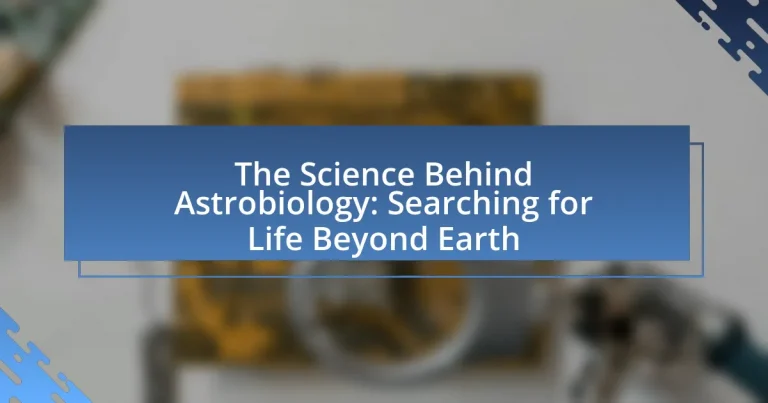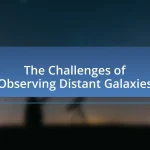Astrobiology is the scientific study of the origin, evolution, distribution, and future of life in the universe, integrating biology, chemistry, geology, and astronomy. This field explores extreme environments on Earth to understand potential extraterrestrial life and investigates biosignatures on other planets, such as Mars and Europa. Key principles include habitability, the search for biosignatures, and the use of various methods like remote sensing and laboratory simulations. Astrobiology plays a crucial role in space exploration, guiding missions to identify conditions that support life and informing future research initiatives. The implications of discovering extraterrestrial life extend to scientific, philosophical, and societal dimensions, raising ethical considerations and prompting a reevaluation of humanity’s place in the cosmos.

What is the Science Behind Astrobiology?
Astrobiology is the scientific study of the origin, evolution, distribution, and future of life in the universe. This interdisciplinary field combines aspects of biology, chemistry, geology, and astronomy to explore the potential for life beyond Earth. Astrobiologists investigate extreme environments on Earth, such as hydrothermal vents and acidic lakes, to understand how life can exist in harsh conditions, which may be analogous to extraterrestrial environments. Research in astrobiology also includes the search for biosignatures, or indicators of life, on other planets and moons, such as Mars and Europa. The validity of astrobiology is supported by discoveries of extremophiles on Earth and the identification of exoplanets in habitable zones, suggesting that life could exist elsewhere in the universe.
How does astrobiology define the search for extraterrestrial life?
Astrobiology defines the search for extraterrestrial life as the scientific study of the origin, evolution, distribution, and future of life in the universe, particularly focusing on the conditions that might support life beyond Earth. This field integrates knowledge from various disciplines, including biology, chemistry, geology, and astronomy, to identify habitable environments on other planets and moons. For instance, the discovery of extremophiles on Earth, organisms that thrive in extreme conditions, has expanded the understanding of potential life forms that could exist in harsh extraterrestrial environments, such as the subsurface oceans of Europa or the methane lakes on Titan.
What are the key principles of astrobiology?
The key principles of astrobiology include the study of the origin, evolution, distribution, and future of life in the universe. This interdisciplinary field combines aspects of biology, chemistry, geology, and astronomy to understand how life might arise elsewhere and what conditions are necessary for its existence. For instance, the principle of habitability focuses on identifying environments that can support life, such as those with liquid water, essential nutrients, and energy sources. Additionally, the search for biosignatures—indicators of past or present life—guides research on other planets and moons, such as Mars and Europa. These principles are supported by findings from missions like the Mars rovers, which have discovered organic molecules and evidence of ancient water, reinforcing the potential for life beyond Earth.
How does astrobiology integrate various scientific disciplines?
Astrobiology integrates various scientific disciplines by combining elements of biology, chemistry, geology, and astronomy to study the potential for life beyond Earth. This interdisciplinary approach allows researchers to explore how life could exist in extreme environments, analyze the chemical building blocks of life, and understand planetary conditions that may support life. For instance, astrobiologists utilize knowledge from microbiology to investigate extremophiles—organisms that thrive in harsh conditions on Earth—to infer how life might survive on other planets. Additionally, the study of planetary geology provides insights into the surface and atmospheric conditions of celestial bodies, while astronomical observations help identify exoplanets within habitable zones. This collaborative framework is essential for developing models of life’s origins and evolution in the universe.
Why is astrobiology important in the context of space exploration?
Astrobiology is important in the context of space exploration because it provides the scientific framework for understanding the potential for life beyond Earth. This field combines biology, chemistry, and planetary science to investigate the conditions necessary for life and to identify habitable environments on other planets. For instance, missions to Mars and the moons of Jupiter and Saturn are guided by astrobiological principles, focusing on the search for water and organic molecules, which are essential for life as we know it. The discovery of extremophiles on Earth, organisms that thrive in extreme conditions, further supports the idea that life could exist in diverse environments across the universe.
What role does astrobiology play in understanding the universe?
Astrobiology plays a crucial role in understanding the universe by investigating the potential for life beyond Earth and the conditions that support it. This interdisciplinary field combines elements of biology, chemistry, and planetary science to explore how life might arise, survive, and evolve in various environments across the cosmos. For instance, the discovery of extremophiles—organisms that thrive in extreme conditions on Earth—has expanded the understanding of where life could exist, such as on Mars or the icy moons of Jupiter and Saturn. Additionally, astrobiology informs the search for exoplanets in habitable zones, enhancing knowledge about the diversity of planetary systems and the potential for life elsewhere.
How can astrobiology inform future missions to other planets?
Astrobiology can inform future missions to other planets by providing insights into the conditions necessary for life and guiding the selection of target environments for exploration. This scientific discipline studies the potential for life in extraterrestrial settings, focusing on factors such as water availability, atmospheric composition, and geological activity. For instance, the discovery of extremophiles on Earth, organisms that thrive in extreme conditions, suggests that life could exist in harsh environments on other planets, such as the subsurface oceans of Europa or the methane lakes on Titan. By understanding these parameters, missions can be designed to search for biosignatures and assess habitability, thereby increasing the likelihood of discovering extraterrestrial life.

What methods are used in astrobiological research?
Astrobiological research employs various methods to investigate the potential for life beyond Earth. These methods include remote sensing, laboratory simulations, field studies, and computational modeling. Remote sensing utilizes telescopes and spacecraft to analyze the atmospheres and surfaces of exoplanets, searching for biosignatures indicative of life. Laboratory simulations recreate extraterrestrial environments, allowing scientists to study the survival and behavior of extremophiles, organisms that thrive in extreme conditions similar to those found on other planets. Field studies involve exploring extreme environments on Earth, such as hydrothermal vents and polar ice caps, to understand how life might exist in similar extraterrestrial settings. Computational modeling helps predict the habitability of celestial bodies by simulating environmental conditions and biological processes. These methods collectively enhance our understanding of life’s potential in the universe.
How do scientists search for signs of life beyond Earth?
Scientists search for signs of life beyond Earth through various methods, including the study of extremophiles, the analysis of planetary atmospheres, and the use of robotic missions. By examining extremophiles—organisms that thrive in extreme conditions on Earth—scientists gain insights into potential life forms that could exist in harsh environments elsewhere in the universe. Additionally, the analysis of planetary atmospheres, such as those of Mars and exoplanets, involves detecting biosignatures like methane or oxygen, which may indicate biological processes. Robotic missions, such as the Mars rovers and the upcoming Europa Clipper, are designed to explore celestial bodies directly, collecting samples and conducting experiments to search for microbial life or organic compounds. These approaches are supported by findings from missions like the Kepler Space Telescope, which has identified thousands of exoplanets, some located in the habitable zone where conditions may support life.
What technologies are employed in astrobiological studies?
Astrobiological studies employ a range of technologies including telescopes, spacecraft, robotic landers, and laboratory simulations. Telescopes, such as the Hubble Space Telescope and the James Webb Space Telescope, are used to observe distant exoplanets and analyze their atmospheres for potential biosignatures. Spacecraft, like the Mars rovers, gather data from planetary surfaces, while robotic landers conduct in-situ analysis of soil and atmospheric samples. Laboratory simulations recreate extraterrestrial environments to test the viability of life under various conditions, providing insights into the potential for life beyond Earth. These technologies collectively enhance our understanding of life’s possibilities in the universe.
How do researchers analyze data from space missions?
Researchers analyze data from space missions by employing a combination of data processing techniques, statistical analysis, and computational modeling. These methods allow scientists to interpret the vast amounts of information collected from instruments aboard spacecraft, such as spectrometers, cameras, and sensors. For instance, data from the Mars Rover missions are processed to identify mineral compositions and search for signs of past water activity, which are crucial for understanding the planet’s habitability. Additionally, researchers utilize machine learning algorithms to detect patterns in the data that may indicate biological activity, enhancing the search for extraterrestrial life. This analytical approach is supported by historical data from previous missions, such as the analysis of Martian meteorites, which has provided insights into the planet’s geological history and potential for life.
What are the challenges faced in astrobiological research?
Astrobiological research faces several significant challenges, primarily including the vastness of space, the limitations of current technology, and the complexity of life itself. The vastness of space makes it difficult to explore and gather data from distant celestial bodies, as the nearest star system, Alpha Centauri, is over four light-years away. Current technology limits our ability to send probes and conduct experiments on these distant worlds, as missions like the Mars rovers take years to develop and execute. Additionally, the complexity of defining and identifying life poses a challenge; scientists must consider various forms of life that may exist under different environmental conditions than those on Earth. These challenges hinder the progress of astrobiological research and the search for extraterrestrial life.
What limitations exist in current astrobiological methods?
Current astrobiological methods face several limitations, primarily related to the challenges of detecting biosignatures and the constraints of existing technology. For instance, many techniques rely on remote sensing, which can struggle to differentiate between biological and abiotic signals, leading to potential false positives. Additionally, the vast distances involved in space exploration limit the ability to conduct in-situ analyses, as seen in missions like Mars rovers, which can only analyze a limited number of samples. Furthermore, the lack of a comprehensive understanding of what constitutes life means that current methods may overlook non-Earth-like forms of life. These limitations highlight the need for advancements in technology and methodology to improve the search for extraterrestrial life.
How do environmental factors affect the search for extraterrestrial life?
Environmental factors significantly influence the search for extraterrestrial life by determining the habitability of celestial bodies. For instance, the presence of liquid water, a stable atmosphere, and suitable temperature ranges are critical for supporting life as we know it. Research indicates that environments similar to Earth’s, such as those found on Mars or the icy moons of Jupiter and Saturn, are prime targets for astrobiological studies. The discovery of extremophiles on Earth, organisms that thrive in extreme conditions, further expands the potential for life in diverse environments beyond our planet.

What are the potential implications of discovering extraterrestrial life?
The potential implications of discovering extraterrestrial life include profound shifts in scientific understanding, philosophical perspectives, and societal dynamics. Scientifically, such a discovery would validate theories regarding the prevalence of life in the universe, prompting a reevaluation of biological and evolutionary principles. For instance, the detection of microbial life on Mars or the moons of Jupiter could suggest that life can arise in diverse environments, challenging the uniqueness of Earth. Philosophically, the existence of extraterrestrial life would raise questions about humanity’s place in the cosmos, potentially altering religious and existential beliefs. Societally, this discovery could lead to increased collaboration among nations in space exploration and research, as well as heightened interest in astrobiology and related fields. Historical precedents, such as the impact of the Copernican Revolution, illustrate how shifts in understanding our place in the universe can lead to significant cultural and intellectual transformations.
How would the discovery of life beyond Earth impact humanity?
The discovery of life beyond Earth would fundamentally alter humanity’s understanding of its place in the universe. This revelation would challenge existing philosophical, religious, and scientific paradigms, prompting a reevaluation of human identity and purpose. For instance, the existence of extraterrestrial life could lead to new scientific inquiries and advancements in technology, as humanity seeks to understand and possibly communicate with these life forms. Historical precedents, such as the Copernican Revolution, illustrate how paradigm shifts in understanding our cosmic position can lead to profound changes in thought and culture. Additionally, the discovery could foster global cooperation, as nations unite in the pursuit of knowledge about life beyond Earth, similar to the collaborative efforts seen in the International Space Station project.
What philosophical questions arise from finding extraterrestrial life?
Finding extraterrestrial life raises several philosophical questions, primarily concerning the nature of existence, consciousness, and humanity’s place in the universe. One significant question is whether extraterrestrial beings possess consciousness and moral status comparable to humans, which challenges existing ethical frameworks. Additionally, the discovery prompts inquiries about the implications for religious beliefs and the concept of a unique human experience, as many religions posit humanity’s special role in creation. Furthermore, the existence of extraterrestrial life could lead to questions about the universality of knowledge and truth, as different civilizations may have distinct understandings of reality. These philosophical inquiries are critical for understanding the broader implications of astrobiological discoveries on human thought and society.
How might such a discovery influence scientific research and funding?
A discovery in astrobiology, such as the identification of microbial life on another planet, could significantly influence scientific research and funding by redirecting resources towards astrobiological studies and related fields. This shift would likely occur because funding agencies prioritize research areas with high potential for groundbreaking findings, as evidenced by the increased budget allocations for NASA’s astrobiology programs following the discovery of extremophiles on Earth, which demonstrated life’s resilience in harsh environments. Consequently, such discoveries can catalyze new research initiatives, attract private investment, and foster interdisciplinary collaborations, ultimately enhancing the scientific community’s capacity to explore life beyond Earth.
What are the ethical considerations in astrobiology?
The ethical considerations in astrobiology include the potential contamination of extraterrestrial environments, the implications of discovering extraterrestrial life, and the responsibilities associated with planetary protection. Contamination concerns arise from the risk of Earth microbes affecting alien ecosystems, which could compromise scientific integrity and the natural evolution of those environments. The discovery of extraterrestrial life raises ethical questions about the rights of such life forms and the moral implications of human intervention. Additionally, planetary protection protocols, established by organizations like NASA and the Committee on Space Research, emphasize the need to prevent harmful biological contamination during space exploration missions. These considerations are crucial for ensuring responsible exploration and maintaining the integrity of both Earth and potential extraterrestrial ecosystems.
How should we approach the potential contamination of other worlds?
To approach the potential contamination of other worlds, we should implement strict planetary protection protocols. These protocols are designed to prevent biological contamination during space exploration missions, ensuring that Earth organisms do not interfere with extraterrestrial ecosystems and vice versa. The Committee on Space Research (COSPAR) provides guidelines that categorize missions based on their potential for contamination, emphasizing the need for sterilization of spacecraft and equipment before launch. For instance, missions to Mars require specific sterilization techniques to mitigate the risk of introducing Earth microbes to the Martian environment, as outlined in the NASA Planetary Protection Policy. This approach is crucial for preserving the integrity of other worlds and for the scientific validity of astrobiological research.
What responsibilities do scientists have in the search for extraterrestrial life?
Scientists have the responsibility to conduct rigorous research and analysis in the search for extraterrestrial life. This includes formulating hypotheses, designing experiments, and utilizing advanced technologies to detect biosignatures on other planets. For instance, the Mars 2020 mission, which includes the Perseverance rover, aims to collect samples that may contain evidence of past microbial life, demonstrating a commitment to empirical investigation. Additionally, scientists must adhere to ethical guidelines, ensuring that their search does not contaminate other celestial bodies, as outlined by the Outer Space Treaty of 1967. This treaty emphasizes the importance of planetary protection, reinforcing the responsibility of scientists to preserve the integrity of extraterrestrial environments while exploring them.
What practical steps can be taken to advance astrobiological research?
To advance astrobiological research, funding for interdisciplinary studies and missions targeting extreme environments on Earth and other celestial bodies is essential. Increased financial support enables the development of advanced technologies for detecting biosignatures and understanding the limits of life. For instance, NASA’s Astrobiology Institute has successfully facilitated collaborations among scientists from various fields, leading to significant discoveries about extremophiles, which are organisms that thrive in extreme conditions, thereby informing the search for life on other planets. Additionally, fostering international partnerships can enhance resource sharing and knowledge exchange, as seen in the collaboration between the European Space Agency and NASA on Mars exploration missions.
How can collaboration between scientists enhance astrobiological studies?
Collaboration between scientists enhances astrobiological studies by integrating diverse expertise and resources, which leads to more comprehensive research outcomes. For instance, interdisciplinary teams combining astrophysics, biology, and geology can develop innovative methodologies to detect biosignatures on other planets. A notable example is the collaboration between NASA and various universities, which has resulted in missions like the Mars Rover, where combined knowledge has improved the search for microbial life. This synergy not only accelerates discovery but also fosters the sharing of data and technology, ultimately enriching the field of astrobiology.
What resources are available for aspiring astrobiologists?
Aspiring astrobiologists have access to a variety of resources, including academic programs, research institutions, online courses, and professional organizations. Notable academic programs can be found at universities such as the Massachusetts Institute of Technology (MIT) and the University of California, Berkeley, which offer specialized degrees in astrobiology and related fields. Research institutions like NASA and the European Space Agency provide opportunities for internships and collaborative projects, allowing students to engage in hands-on research. Online platforms such as Coursera and edX offer courses on astrobiology, planetary science, and related topics, making education accessible to a wider audience. Additionally, organizations like the Astrobiology Society and the Planetary Society offer networking opportunities, conferences, and resources for professional development, further supporting the aspirations of those interested in this field.


